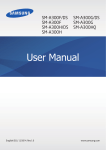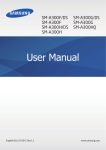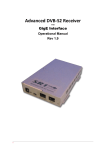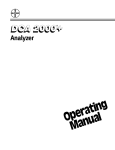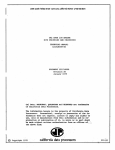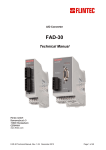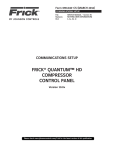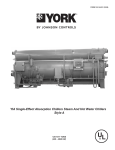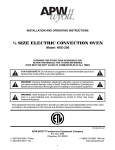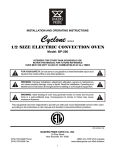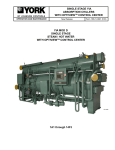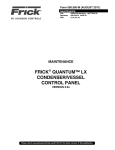Download "service manual"
Transcript
Form S70-400 OM (JUN 1999) OPERATION - MAINTENANCE File: Replaces: Dist: SERVICE MANUAL - Section 70 NOTHING (New Information) 3, 3a, 3b, 3c RXF ROTARY SCREW COMPRESSOR UNITS "MINI" MICROPROCESSOR CONTROL THIS MANUAL CONTAINS OPERATION AND MAINTENANCE INSTRUCTIONS. READ THOROUGHLY BEFORE BEGINNING INSTALLATION. FAILURE TO FOLLOW THESE INSTRUCTIONS COULD RESULT IN DAMAGE OR IMPROPER OPERATION OF THE UNIT. S70-400 OM (JUN 99) Page 2 RXF "MINI" MICROPROCESSOR CONTROL OPERATION - MAINTENANCE Contents "MINI" MICROPROCESSOR CONTROL PANEL .......................................................................................................................... 3 KEYS AND KEY FUNCTIONS ...................................................................................................................................................... 4 OPERATING DISPLAY .................................................................................................................................................................. 4 SETPOINTS DISPLAY .................................................................................................................................................................. 5 TO CHANGE THE ADJUSTABLE SETPOINTS: ........................................................................................................................... 6 HOW TO DETERMINE ADJUSTABLE SETPOINTS: .................................................................................................................... 6 SETPOINTS DISPLAY, Fixed, Page 1 * ........................................................................................................................................ 7 SETPOINTS DISPLAY, Fixed, Page 2 * ........................................................................................................................................ 7 ANNUNCIATOR DISPLAY ............................................................................................................................................................. 7 SECURITY DISPLAY * .................................................................................................................................................................. 9 COMMUNICATIONS DISPLAY * ................................................................................................................................................... 9 AUTO-CYCLE DISPLAY * ............................................................................................................................................................. 9 ANALOG OFFSET DISPLAY ........................................................................................................................................................ 9 HOW THE MICROPROCESSOR WORKS SUMMARY .............................................................................................................. 10 MULTIPLE COMPRESSOR SEQUENCING ............................................................................................................................... 11 MICROPROCESSOR OUTPUT DATA CODE ............................................................................................................................. 11 MICROPROCESSOR TELECOMMUNICATIONS ....................................................................................................................... 11 COMMUNICATIONS PROTOCOL SPECIFICATIONS: ............................................................................................................... 11 TROUBLESHOOTING THE RXF MICROPROCESSOR............................................................................................................. 14 GENERAL INFORMATION.......................................................................................................................................................... 14 TROUBLESHOOTING FRICK SBC MICROPROCESSOR SYSTEM ......................................................................................... 14 EPROM MEMORY I/C CHIP REPLACEMENT ........................................................................................................................... 16 SBC BOARD REPLACEMENT.................................................................................................................................................... 16 MICROPROCESSOR DISPLAY REPLACEMENT ...................................................................................................................... 16 FUSE REPLACEMENT ............................................................................................................................................................... 16 MICROPANEL ASSEMBLY WIRING DIAGRAM ......................................................................................................................... 18 RXF "MINI" MICROPROCESSOR CONTROL OPERATION S70-400 OM (JUN 99) Page 3 Operation "MINI" MICROPROCESSOR CONTROL PANEL THE FOLLOWING MUST BE READ, AND UNDERSTOOD, IN ADDITION TO THE OPERATING AND STARTUP INSTRUCTIONS IN S70-200 IOM, BEFORE ATTEMPTING TO START OR OPERATE THE UNIT. The RXF compressor is controlled by a state-of-the-art microprocessor control system. The microprocessor continuously monitors the compressor unit’s condition and operation. The microprocessor also directs instructions to the various compressor unit subsystems. The microprocessor has a membrane switch keyboard. Pressing the keyboard in the area outlined as a key will cause that function to be recognized by the microprocessor. The keyboard has 32 membrane-type keys. In addition to the keyboard, there is an emergency stop button. Pushing the emergency stop will bypass the computer and remove all power from the outputs. This will shut down the compressor motor and all control power (120v) to the compressor auxiliary systems such as the oil pump and liquid injection solenoid. THE EMERGENCY STOP BUTTON IS FOR EMERGENCY SHUTDOWN SITUATIONS ONLY AND MUST NOT BE USED TO ROUTINELY SHUT OFF THE COMPRESSOR. The microprocessor hardware contains an internal watchdog circuit. If the microprocessor should fail, this circuit will disable (turn off) all outputs. S70-400 OM (JUN 99) Page 4 RXF "MINI" MICROPROCESSOR CONTROL OPERATION KEYS AND KEY FUNCTIONS The [CHANGE] key rotates the display through the different display screens. The [CHANGE] key is also used to change the status of various setpoints. This key, when pressed, will cause the existing settings to be replaced with “#” symbol for each number of the setting. To change from pounds per square inch (G) to inches of mercury (HG) press the [CHANGE] key when the (G) or (HG) is flashing. The [STEP] key steps or moves a set of flashing characters through the Adjustable setpoints on the Setpoints displays, the Auto-cycle display and the Security display. The setpoint replaced by the flashing “#” symbol may be changed or updated. The [STEP] key is also used when the Annunciator display is selected to step through the annunciator’s information displays. NOTE: The [ * ] key is used to step or move to previous screens, described above, one at a time. The [ENTER] key is used to change or enter new setpoints. The [CLEAR] key will reset an alarm or cutout indication on the annunciator screen(s) and will clear the microprocessor to allow continued operation or restarting if all conditions have returned to normal and no other control lockouts are in force. The [NUMERIC KEYPAD] is used to introduce new setpoint limits. The [+/-] key will call up the Analog Offset display, page 1, then page 2. The [RUN], [STOP], and [REMOTE START] keys control the starting and stopping of the compressor unit. The [ALARM SILENCE] key will de-energize the alarm horn output. The [AUTO], [REMOTE], and [MANUAL] keys control the operation of the compressor slide valve. The [AUTO], [MANUAL 2.2], [MANUAL 3.5], and [MANUAL 5.0] keys control the operation of the compressor slide stop. The [F1] function key will return the operator to the main operating display. This function may be invoked at any time, even during setpoint entry. The [F2] function key will call up the Security display. NOTE: Press the [F2] key, as prompted by the display, to return to the previously selected display. The [F3] function key is nonoperational. The [F4] function key will call up the Auto Cycle display. NOTE: To exit the Auto Cycle display, press the [F1] key as prompted by the display. The microprocessor has a liquid crystal display in a 2 line by 20 character format, for a total of 40 characters. There are 6 different display modes with a total of 36 possible displays. When power is first applied to the control panel, the unit will be in the Operating display mode. To change to a different display mode, press the [CHANGE] key. The display modes in their order of rotation are: 1. 2. 3. 4. Operating display (5 Pages) Setpoints display (7 Pages) Annunciator display (22 Pages) Communications display (1 Page) [F2] Security display [F4] Auto Cycle display OPERATING DISPLAY OPERATING DISPLAY, Page 1 * SUCT DISH OIL // G ///G ///G mode state The Operating display is continuously updated and provides a variety of information in regard to the current status of the compressor’s condition and performance. The information furnished by the Operating display is as follows: SUCT - Suction Pressure is measured at the compressor inlet and is displayed in pounds per square inch gauge (G) or in inches of mercury (HG). DISH - Discharge Pressure is measured at the compressor outlet and is displayed in pounds per square inch gauge (G). OIL - Oil Pressure is measured prior to entering the compressor and is displayed in pounds per square inch gauge (G). mode - mode displays the status of the compressor unit. The mode of operation will be indicated as either manual (MAN) when the [RUN] key has been pressed, automatic (AUTO) when Auto Cycle has been activated, remote (RMT) when the [RMT] key has been pressed, or off (OFF MODE). state - state displays the current condition of the compressor unit. The display will indicate if the unit is running (RUNG), off (OFF), shutdown (SHUTD) because of some compressor or system condition or alarm (ALARM) when there is an alarm condition. OPERATING DISPLAY, Page 2 * DISCH OIL SEPARATOR ///F ///F ///F DISCH - Discharge Temperature in degrees Fahrenheit is displayed. OIL - Oil Temperature is displayed in degrees Fahrenheit. SEPARATOR - Separator displays the oil separator temperature in degrees Fahrenheit. * Display for illustrative purposes only. RXF "MINI" MICROPROCESSOR CONTROL OPERATION OPERATING DISPLAY, Page 3 * COMP-mode FLA HEATER state ///% OFF COMP - Compressor mode indicates whether the compressor is in automatic (AUTO), remote (RMT), or manual (MAN) operating mode. STATE - state indicates the unit operating condition when running (RUNG), off (OFF), shutdown (SHUTD), or (ALARM). FLA - Percent Full-Load Amps displays the percentage of the drive motor full-load amperage rating that the motor is currently using. HEATER - Heater displays the condition of the oil separator heater(s), indicating ON or OFF. OPERATING DISPLAY, Page 4 * S.V.///% CAP.CON=//G AUTO-L SUCT.P.=//G S70-400 OM (JUN 99) Page 5 this, an information space has been provided to indicate whether V ratio is in the automatic (AUTO) or the manual (MAN) mode. RECYCLE - A Recycle Delay message indicates that the compressor has started and has shut down within the time delay setpoint period. The Recycle Delay will prevent the compressor from starting until the delay time expires and is intended to prevent damage to the compressor motor from successive restarts. During Recycle Delay, the microprocessor will alternatively flash “RECYCLE DELAY” and the remaining delay time in minutes. The (RECYCLE . . .) message appears only when the compressor is in the recycle mode. NOTE: Consult Motor Manufacturer for the recommended duration of the Recycle Delay. If the [RUN] key is pushed while the unit is in Recycle Delay, the compressor will start at the end of the delay period. SETPOINTS DISPLAY SETPOINTS DISPLAY, Adjustable, Page 1 * S.V. % - Slide valve position is displayed as a percentage. This percentage reflects the mechanical position of the slide valve and does not reflect the percentage of full-load operation. Immediately below this information, space has been provided to indicate whether the S.V. % is in the automatic (AUTO), manual (MAN), or remote (RMT) mode. The microprocessor will control this function in the automatic mode. To the right of the mode indicator, three other messages may appear: L - indicates Slide Valve loading. U - indicates Slide Valve unloading. FU - indicates Slide Valve forced unloading. A Forced Unload (FU) message indicates that the percentage of motor full-load amps has exceeded the maximum limit and the microprocessor is unloading the compressor until the percentage FLA falls back to normal limits. CAP CON - The Capacity Control setpoint, reported in pounds per square inch gauge (G) or inches of mercury (HG), controls the loading and unloading of the compressor when S.V. is in the automatic (AUTO) mode. SUCT.P. - Suction Pressure is measured at the compressor inlet and is displayed in pounds per square inch gauge (G) or in inches of mercury (HG). This is the same value as shown on “Operating Display, Page 1.” OPERATING DISPLAY, Page 5 * VOLUME RATIO - /./ AUTO RECYCLE 30 MIN VOLUME RATIO - Volume Ratio is the ratio selected by the microprocessor to provide the highest efficiency at any given suction and discharge pressure condition. Immediately below * Display for illustrative purposes only. CCSP=//G LPCO=//G LPA =//G The information furnished by the Adjustable Setpoints of the Setpoints display is as follows. CCSP - The Capacity Control Setpoint, reported in pounds per square inch gauge (G) or inches of mercury (HG), controls the loading and unloading of the compressor when S.V. is in the automatic (AUTO) mode. LPCO - The Low Suction Pressure Cutout, reported in pounds per square inch gauge (G) or inches of mercury (H), will shut down the compressor if the suction pressure drops to this limit or lower, for 90 seconds or longer. LPA - The Low Suction Pressure Alarm, reported in pounds per square inch gauge (G) or inches of mercury (HG), will trigger a prealarm if the suction pressure drops to this limit or lower. SETPOINTS DISPLAY, Adjustable, Page 2 * PB DB CT 15 1.0 10 PB - The Proportional Band (PB) is used to determine the amount of time the load/unload solenoid is energized, according to how far away from the setpoint the actual control pressure or temperature is. The smaller the number, the more load/unload will be sent. A PB of 10% is default. It is adjustable to 2, 5, 10, 15, 20, or 25 percent. DB - The Dead Band (DB) is a + (plus) or - (minus) value above or below the setpoint at which the compressor will neither load nor unload. It is adjustable between .5 and 5.0 psig or degrees, in increments of .5 units. S70-400 OM (JUN 99) Page 6 RXF "MINI" MICROPROCESSOR CONTROL OPERATION CT - The Cycle Time (CT) setpoint is the amount of time between the beginning of each load/unload response. It is adjustable to 5, 10, 15, 20, 25, or 30 seconds. Use the [STEP] key to step to the desired setpoint, then press the [CHANGE] key to change the CC, PB, DB, and CT values. Enter the desired value for the remaining setpoints and press [ENTER] when complete. SETPOINTS DISPLAY, Adjustable, Page 3 * HPCO=///G AUX1-A-NC HPA =///G AUX2-S-NO HPCO - The High Discharge Pressure Cutout, reported in pounds per square inch gauge (G), will shut down the compressor if the discharge pressure equals or exceeds this setpoint. HPA - The High Discharge Pressure Alarm, reported in pounds per square inch gauge (G) will trigger a prealarm if the discharge pressure equals or exceeds this setpoint. AUX 1 and AUX 2 - May be configured for either an alarm or shutdown and with either a normally closed (NC) or normally open (NO) contact. SETPOINTS DISPLAY, Adjustable, Page 4 * RECYCLE DELAY=30 MIN C.T. FACTOR =/// RECYCLE DELAY - The Recycle Delay displays the current recycle delay setpoint in minutes. NOTE: Consult motor manufacturer for recommended setpoint. CT FACTOR - The Current Transformer Factor records the proper current transformer factor to match the compressor motor FLA rating to the current transformer primary amp rating. The CTF factor is programmable and its correct value is determined by the following formula: CTF = 1024 x FLA (Full Load Amps *) 10x CT (Current Transformer Primary Amps **) * See motor nameplate. ** See CT located in starter panel. EXAMPLE: FLA = 230 Amps CT = 300 (300:5) CTF = 1024 x 230 = 80 (Round to whole number) 10 x 300 SETPOINTS DISPLAY, Adjustable, Page 5 * MLC STOP LOAD=/// % MLC FORCE UNLD=/// % MLC STOP LOAD - The Motor Load Control Stop Load (MLSL), reported as a percentage of the motor full load amps (FLA), will prevent the compressor capacity control from loading when the setpoint is equaled or exceeded. NOTE: Consult motor manufacturer for recommended setpoint. MLC FORCE UNLD - The Motor Load Control Force Unload (MLFU), reported as a percentage of the motor full-load amps (FLA), will force the compressor to unload until the motor full-load amps (FLA) falls to less than the stop load setpoint. MLFU will show on display when active. NOTE: Consult motor manufacturer for recommended setpoint. TO CHANGE THE ADJUSTABLE SETPOINTS: Adjustable Setpoints are stored in memory and are easily changed in the field. Although the Adjustable Setpoints are not lost if power is interrupted, we suggest that a list of Adjustable Setpoints be affixed to one end of the microprocessor cabinet for reference. NOTE: The following procedure also applies to the changing of the Security and Auto Cycle display setpoints. 1. Press the [CHANGE] key to rotate the display to any of the Adjustable Setpoints displays (Pages 1, 2, 3, 4, or 5). 2. Press the [STEP] key to move or step through the various setpoints. A setpoint is selected for change or update when it is flashing. 3. Having selected the setpoint to be changed, the [NUMERIC KEYPAD] may be used to enter the new setpoint. NOTE: All digits must be entered, including zeros. For example, (01.0). NOTE: The AUX 1 and AUX 2 setpoints, once selected, are changed or updated by pressing the [CHANGE] key. NOTE: Certain setpoints may be reported in either pounds per square inch gauge (G) or inches of mercury (HG). Having selected the setpoint, press the [CHANGE] key to toggle between (G) and (HG). 4. In the event that an incorrect setpoint is keyed in, press the [CLEAR] key to restore the original setpoint. Pressing the [CLEAR] key a second time will eliminate the flashing characters. 5. Having keyed in the desired setpoint, press the [ENTER] key. The new setpoint will be entered and the next adjustable setpoint will begin flashing. NOTE: A setpoint entry outside the parameters of the Adjustable Setpoint display will be refused. HOW TO DETERMINE ADJUSTABLE SETPOINTS: Adjustable Setpoints should reflect values compatible with normal system operation. Too high a Low Suction Pressure Alarm setpoint may cause nuisance prealarms. Similarly, cutout setpoints should not fall within what are considered normal plant operation. As a rule of thumb, set the Low Suction Pressure Alarm 5 PSIG lower than the lowest normal suction pressure. The Low Suction Pressure Cutout should be 5 to 10 PSIG lower than the Low Suction Pressure Alarm setpoint. * Display for illustrative purposes only. RXF "MINI" MICROPROCESSOR CONTROL OPERATION The High Discharge Pressure Cutout should be set at 90% of the setting of the lowest high side relief valve. The High Discharge Pressure Alarm should be set 10 PSIG lower than the Cutout. The Capacity Control setpoint should be the equivalent of the normal suction condition. SETPOINTS DISPLAY, Fixed, Page 1 * HDTC=212 HOTC=167 HDTA=194 HOTA=159 HDTC - The High Discharge Temperature Cutout, reported in degrees Fahrenheit, will shut down the compressor if the discharge temperature equals or exceeds this setpoint. HDTA - The High Discharge Temperature Alarm, reported in degrees Fahrenheit, will shut down the compressor if the oil temperature equals or exceeds this setpoint. HOTC - The High Oil Temperature Cutout, reported in degrees Fahrenheit, will shut down the compressor if the oil temperature equals or exceeds this setpoint. HOTA - The High Oil Temperature Alarm, reported in degrees Fahrenheit, will trigger a prealarm if the oil temperature equals or exceeds this setpoint. SETPOINTS DISPLAY, Fixed, Page 2 * LOTC=49 HON =113 LOTA=58 HOFF=122 LOTC - The Low Oil Temperature Cutout, reported in degrees Fahrenheit, will shut down the compressor if the oil temperature equals or falls below this setpoint. LOTA - The Low Oil Temperature Alarm, reported in degrees Fahrenheit, will trigger a prealarm if the oil temperature equals or falls below this setpoint. HON - The setpoint, in degrees Fahrenheit, to turn on the oil heater when the oil temperature in the oil separator equals or falls below this setpoint. HOFF - The setpoint, in degrees Fahrenheit, to turn off the oil heater when the oil temperature in the oil separator equals this setpoint. Compressor Differential Cutout between Suction and Discharge - The differential cutout has been lowered from 55 lb to 25 lb. Cutout will occur after five minutes. To allow operation at low differential pressures, the micro will take the following steps: A. Force unload the compressor to 50% and display an "F Unload" when the oil pressure is within 10 lb of the main oil injection port pressure and the slide valve position is greater than 50%. B. Prohibit the compressor from loading and display a "Ld Inhib" message when the differential is within 15 lb of the main oil injection port pressure. Oil Pressure Alarm and cutout - Logic has been revised to same logic as currently used on RXB/RXF. The new logic is as follows: S70-400 OM (JUN 99) Page 7 Alarm will occur if oil pressure is 25 lb below discharge pressure or within 10 lb of suction pressure for 30 seconds. Cutout occurs if oil pressure is 30 lb below discharge pressure or if oil pressure is within 7 lb of suction pressure for 10 seconds and alarm has already been set. ANNUNCIATOR DISPLAY When a prealarm or cutout occurs, a flashing ALARM or SHUTD (shutdown) indicator will appear in the lower right hand corner of the “Operating Display, Page 1” and in the lower left hand corner of “Operating Display, Page 3”. To determine the fault, rotate to the Annunciator display by pressing the [CHANGE] key. The Annunciator display will show all failures, individually. If there is only one failure, the annunciator display will appear as shown on the following “Annunciator Display's”. When the system has failed for more than one condition, (USE STEP) will appear in the upper right side of the display. The applicable failure displays will be individually rotated through by pressing the [STEP] key. Continued pressing of the [STEP] key will result in the applicable failure displays repeating. Pressing the [CLEAR] key while at the Annunciator display will clear all alarms and/or cutouts. In order to restore the Annunciator display and resume normal operation, it will be necessary to go through the following steps: 1. Correct the conditions causing the alarm. 2. Press the [ALARM SILENCE] key. (This action may precede correcting the conditions causing the alarm). 3. To clear or reset the Annunciator pages, press the [CLEAR] key. This will also clear the ALARM, SHUTD, or CUTOUT indicator from the Operating display. 4. Press [F1] to call up the Operating display. If the conditions causing the alarm have not been corrected or a new fault has occurred, the ALARM, SHUTD, or CUTOUT message will appear. NOTE: Use of the Emergency Stop Button may trip one or more alarm setpoints. 5. After all failures have been corrected and the [CLEAR] key has been pressed and if there are no failures, the Annunciator display will show (NO FAILURES). ANNUNCIATOR DISPLAY, NO FAILURES* ANNUNCIATOR NO FAILURES ANNUNCIATOR DISPLAY, 1 FAILURE* ANNUNCIATOR HIGH PRESSURE CUTOUT * Display for illustrative purposes only. S70-400 OM (JUN 99) Page 8 RXF "MINI" MICROPROCESSOR CONTROL OPERATION ANNUNCIATOR DISPLAY, MULTIPLE FAILURES* ANNUNCIATOR USE STEP HIGH PRESS ALARM ANNUNCIATOR DISPLAY* ANNUNCIATOR DISCH TEMP ALARM ANNUNCIATOR DISPLAY* The remaining screens show additional failure messages that may appear. ANNUNCIATOR COMPRESSOR AUXILIARY ANNUNCIATOR DISPLAY* ANNUNCIATOR LOW PRESS CUTOUT ANNUNCIATOR DISPLAY* ANNUNCIATOR OIL LEVEL ANNUNCIATOR DISPLAY* ANNUNCIATOR LOW PRESS ALARM ANNUNCIATOR DISPLAY* ANNUNCIATOR COMP DIFFERENTIAL ANNUNCIATOR DISPLAY* ANNUNCIATOR OIL PRESS CUTOUT ANNUNCIATOR DISPLAY* ANNUNCIATOR AUX #1 ALARM ANNUNCIATOR DISPLAY* ANNUNCIATOR OIL PRESS ALARM ANNUNCIATOR DISPLAY* ANNUNCIATOR AUX #1 SHUTDOWN ANNUNCIATOR DISPLAY* ANNUNCIATOR HI OIL TEMP CUTOUT ANNUNCIATOR DISPLAY* ANNUNCIATOR AUX #2 ALARM ANNUNCIATOR DISPLAY* ANNUNCIATOR HI OIL TEMP ALARM ANNUNCIATOR DISPLAY* ANNUNCIATOR AUX #2 SHUTDOWN ANNUNCIATOR DISPLAY* ANNUNCIATOR LO OIL TEMP CUTOUT ANNUNCIATOR DISPLAY* ANNUNCIATOR BAD E2PROM CHIP ANNUNCIATOR DISPLAY* ANNUNCIATOR LO OIL TEMP ALARM ANNUNCIATOR DISPLAY* ANNUNCIATOR SENSOR FAULT ANNUNCIATOR DISPLAY* ANNUNCIATOR DISCH TEMP CUTOUT * Display for illustrative purposes only. RXF "MINI" MICROPROCESSOR CONTROL OPERATION SECURITY DISPLAY * KEYBD ENTRY ENABLED ENTER CODE ***** The [F2] function key will call up the Security display. The Security display allows the operator to either enable or disable the microprocessor’s keyboard to prevent unauthorized tampering with the various adjustable setpoints. When enabled, the microprocessor keyboard is fully operative and the security lockout is not in effect. When disabled, the keyboard is rendered partially nonfunctional. All displays will still be accessible through the keyboard. If any attempt is made to enter new adjustable setpoints, however, the microprocessor will default to the Security display. TO ENABLE THE KEYBOARD, press the [STEP] key so that the Enter Access Code asterisks (*****) flash, key the proper five digit access code, and press [ENTER]. The Setpoints Access will toggle from disabled to enabled and adjustable setpoint entry is now possible. TO DISABLE THE KEYBOARD, press the [F2] function key to call up the Security display. Press the [STEP] key until the Enter Access Code asterisks (*****) flash, key the proper five digit access code, and press [ENTER]. Now, press the [STEP] key until ENABLED/DISABLED beside KEYBD ENTRY flash and press the [CHANGE] key to toggle from enabled to disabled. TO CHANGE THE ACCESS CODE, press the [F2] function key to call up the Security display. Press the [STEP] key until the Enter Access Code asterisks (*****) flash, key the proper five digit access code, and press [ENTER]. Now, select the Enter Access Code a second time by pressing the [STEP] key until the asterisks flash, key in the new five digit access code, and press [ENTER]. NOTE: Power loss will not affect the Security display. NOTE: IF NO ACCESS CODE WAS ENTERED AND THE DISABLED COMMAND WAS SELECTED, THE ACCESS CODE IS [00000]. LOST OR FORGOTTEN ACCESS CODE: Consult Frick for assistance. COMMUNICATIONS DISPLAY * COMMUNICATIONS ID# = 33 BAUD = 9600 ID - The ID number is a programmable identification code used in telecommunications to access a specific compressor. BAUD - Shows the baud rate of the RS-422 communication port. Both ports are configured as follows: word = 8 bit, parity = none or even, stop = 1 bit. The communications port is programmable from 300 to 19200 baud. * Display for illustrative purposes only. S70-400 OM (JUN 99) Page 9 AUTO-CYCLE DISPLAY * START=//G MIN.SV.=// STOP =//G ENABLE=YES The Auto Cycle display is accessed by pressing [F4]. The Auto Cycle display provides for independently adjustable setpoints to turn the compressor on and off in response to the suction pressure or as an adjustable setpoint to limit the minimum slide valve position. NOTE: To change the Auto Cycle setpoints, refer to “TO CHANGE THE ADJUSTABLE SETPOINTS”. START - Compressor Start-up will bring the compressor back on line when the suction pressure rises to the displayed setpoint. STOP - Compressor Stop will shut down the unit if the suction pressure drops to or below the displayed setpoint limit. NOTE: This limit must be set higher than Low Suction Pressure Cutout and the Low Suction Pressure Alarm setpoints. MIN. SV - Minimum Slide Valve Position, shown as a percentage, will limit the slide valve position to the displayed setpoint. ENABLE - Indicates whether Auto Cycle is active (YES) or not active (NO). Press the [CHANGE] key while at this setpoint to change the status. Upon deactivation, the compressor will return to the previous mode of operation. The Analog Offset Display is accessed by pressing [+/-] key. ANALOG OFFSET DISPLAY, PAGE 1 * SUCT DISCH OIL TEMP. +0 +1 -1 ANALOG OFFSET DISPLAY, PAGE 2 * DISCH OIL SEP TEMP. +0 +0 +2 All analog values can be offset + or - 5 units, depending on which value is being adjusted. Use the [STEP] key to step through the desired setpoint. Press the [CHANGE] key to change the value of the offset by 1. The actual analog value will be displayed under the word “PRESS” or “TEMP”. S70-400 OM (JUN 99) Page 10 RXF "MINI" MICROPROCESSOR CONTROL OPERATION - MAINTENANCE HOW THE MICROPROCESSOR WORKS SUMMARY The Frick microprocessor has 3 major components and a variety of sensors. The major components are the SBC (single board computer) 1 display screen, and the keyboard. The SBC can be considered the brain of the microprocessor control console. The SBC contains the logic center which provides the rules by which the microprocessor will operate, the integrated circuit chips which store the burned in memory of how the compressor unit is to behave, an analog input to convert Volts DC from the various sensors into computer binary language, and RAM (random access memory) integrated circuit chips to store information which can be readily changed by the microprocessor or, as in the case of adjustable setpoints, by the operator. The SBC collects information, processes the information, and delivers instructions to the displays and to the output modules. The SBC gathers information from several sources on the compressor unit. Pressure transducers sense changes in pressure and return a variable DC voltage of 1 to 5 VDC to the SBC. The signals are converted into binary code which the microprocessor understands. The microprocessor scans the incoming data many times per second and compares the information it receives with the instructions programmed in the PROM chips, information stored in the RAM chips, and instructions it has received from the console keyboard. As operating conditions change, the microprocessor also forwards the information it is receiving to the display screen. When an operating condition or conditions develop which the microprocessor program identifies as requiring a specific action, the microprocessor generates an instruction which is forwarded to the output modules. The instruction triggers a solid state output device capable of handling control voltage and the instruction is executed. If the microprocessor receives information that indicates an abnormal operating condition has been reached or is present, it will generate one or more of the following instructions: 1. If a subsystem on the compressor unit, such as the oil heater(s) or liquid injection, can correct the problem, the microprocessor will energize or deenergize this system. 2. If an alarm setpoint has been reached,the microprocessor will trigger the alarm and display this information on the Operating display and the Annunciator display. 3. If a cutout setpoint has been reached,the microprocessor will trigger the cutout and shut down the compressor. The microprocessor will indicate CUTOUT on the Operating display. Information will be available through the Annunciator display. A typical example of how the microprocessor responds can be illustrated by the responses generated by the microprocessor as oil temperature increases. Assume that the ambient temperature and compressor unit temperature is 45OF, liquid injection, R-22 refrigerant and you have just pressed the [RUN] key to start the compressor unit: AT 45OF Microprocessor receives information that the oil temperature is below 49OF, the low oil temperature cutout setpoint, and triggers a cutout. The microprocessor will prevent the compressor package from being started. The microprocessor also instructs the oil heater(s) output to energize the oil heater(s). AT 50°F When the oil temperature reached 50OF the microprocessor would allow the Low Oil Temperature Cutout to be cleared and the compressor unit could now be started. (Assume that the [RUN] key has been pressed and that the compressor has now started.) The low oil temperature alarm would still be engaged and cannot be cleared until oil temperature exceeds 58OF. The oil heater(s) shut off on compressor start. AT 113°F The microprocessor instructs the liquid injection solenoid output to deenergize the liquid injection solenoid. AT 122°F The microprocessor instructs liquid injection solenoid output to energize and the oil heater(s) output to deenergize (This is a fail-safe. The heater(s) should already be deenergized due to compressor running.) AT 50° TO 157°F Normal operating range. The microprocessor continues monitoring oil temperature and reporting this information on the Operating display. AT 158°F The microprocessor triggers the High Oil Temperature Alarm and displays the alarm on the Operating display and the Annunciator display. AT 167°F The microprocessor instructs the compressor motor to shut down and displays a SHUTD indication on the Operating display. Information regarding the cutout will also be retained by the Annunciator display(s). NOTE: If the operator makes an error by attempting to start the compressor under conditions outside safe normal operating conditions, the microprocessor will prevent start-up and advise the operator of the fault. RXF "MINI" MICROPROCESSOR CONTROL OPERATION - MAINTENANCE MULTIPLE COMPRESSOR SEQUENCING FOR RXF COMPRESSOR UNITS WITH MICROPROCESSOR CONTROLS A - The standard microprocessor panel includes: 1. Remote Run Input 2. Remote Load Input 3. Remote Unload Input The remote run input is only recognized when the remote run mode has been selected by pressing the “remote start” key on the front panel of the microprocessor. MICROPROCESSOR TELECOMMUNICATIONS The Frick RXF Microprocessor comes with an onboard telecommunications interface. The telecommunications feature permits interfacing the microprocessor with a modem, remote data communications terminal, or master computer via RS-422 protocol. In the case of a modem, telephone lines are used for the actual transmission of data permitting communications from a remote location. The components necessary to utilize the telecommunications feature will vary with the application. Information concerning these items may be obtained from Frick, Waynesboro, Pa. The remote load and unload inputs can only be recognized when the [remote] key in the slide valve column on the front panel of the microprocessor has been pressed. B - A master sequence controller must be installed to provide the signals to remote start and stop the compressors and remote load and unload the compressors based on the common suction pressure or other parameter. The customer may supply his own master sequencer panel (usually a programmable controller) or Frick can supply this sequencer, if desired (contact Frick for pricing). S70-400 OM (JUN 99) Page 11 COMMUNICATIONS PROTOCOL SPECIFICATIONS: All commands must be in ASCII (CAPS) to be recognized. A compressor with an ID code of [00] is considered disabled. ID Codes from [01] thru [99] are valid and are recognized by the microprocessor. The following is a complete list of available command types: COMMAND CODE and DESCRIPTION I R S V P T A C = = = = = = = = Returns compressor status information. Compressor start command. Compressor stop command. Compressor capacity control command. Return Pressures information. Return Temperatures information. Return full load amps information. Enter Change setpoints mode. The following is a detailed description of each command: RETURN COMPRESSOR STATUS INFORMATION: # 01 I Start of command sequence. Compressor ID code. Return Status information command. RETURNED ANSWER, ie: MICROPROCESSOR OUTPUT DATA CODE A 3.5 K OHM, 10 watt resistor (RES) must be field installed, as shown below, when the 120 VAC outputs of the RXF are driving 120 VAC solid state input devices such as programmable controllers. Character Position 1,2,3 4 5 6 7 8,9,10 090RRRN340 Description of returned data Capacity control position. Remote, Auto, Manual (Cap control) Delay-recycle, Running, Off. Rem, Man, Off, Auto (Compressor mode) Cutout, Alarm, Normal. Suction in PSIA. (Carriage return, line feed.) COMPRESSOR START COMMAND: # 01 R 01 #01I #01R01 Start command sequence. Compressor ID code. Start compressor command. ID code repeated for verification NOTE: The compressor must be in the remote start mode for this command to be executed. Returned answer: A01 Character Position 1 2,3 Description of returned data Acknowledge of command sent. ID code of compressor. (Carriage return, line feed.) S70-400 OM (JUN 99) Page 12 RXF "MINI" MICROPROCESSOR CONTROL OPERATION - MAINTENANCE COMPRESSOR STOP COMMAND: # 01 S 01 #01S01 RETURN PRESSURES COMMAND: Start command sequence. Compressor ID code. Stop compressor command. ID code repeated for verification NOTE: The compressor must be in the remote start mode for this command to be executed. RETURNED ANSWER: Character Position # 01 P Start command sequence. Compressor ID code. Return pressures command. X X X X S D O A = = = = Return Return Return Return #01PX suction pressure (PSIA). discharge pressure (g/hg). oil pressure (g). all pressures. A01 If the command was #01PS, then the microprocessor would dump the suction pressure. Description of returned data RETURNED ANSWER: 1 2,3 Acknowledge of command sent. ID code of compressor. (Carriage return, line feed.) XXX = 3 characters followed by a carriage return, line feed. If using the "A" command, then the returned data would be: COMPRESSOR SLIDE VALVE CONTROL COMMANDS: # 01 V #01VLXX #01VUXX #01VS #01VP XXXXXXXXX = 9 characters followed by a carriage return, line feed. L U Start command sequence. Compressor ID code. Compressor control command. Load Slide valve command. Unload slide valve command. XX = 00 Turns selected output off. XX = 01 to 15 Turns selected output on for XX seconds. XX = 99 Turns selected output on. Return slide valve position value. Return slide stop position value. S P If the command was #01VL00, then the load slide valve output on compressor #1 would be turned off. If the command was #01VL05, then the load slide valve output on compressor #1 would be turned on for 5 seconds, and would then automatically turn off. NOTE: the slide valve must be in the remote mode for this command to be executed. RETURNED ANSWER (for L or U commands): Character Position 1 2,3 A01 Description of returned data Acknowledge of command sent. ID code of compressor. (Carriage return, line feed.) RETURNED ANSWER (for S command), ie: 090 1,2,3 Slide valve position. RETURNED ANSWER (for P command), ie: 2.2 (Carriage return, line feed) RETURN TEMPERATURES COMMAND: # 01 T X X X X Start command sequence. Compressor ID code. Return temperature command. = = = = D O P A RETURNED ANSWER: XXXX = 4 characters followed by a carriage return, line feed for suction. XXX = 3 characters followed by a carriage return, line feed for discharge, oil, and separator. If using the "A" command, then the returned data would be: XXXXXXXXX # 01 D Auto mode. Remote mode. #01DX Start command sequence. Compressor ID code. Compressor control command. X = S X = A X = R = 9 characters followed by carriage return, line feed. COMPRESSOR DISPLAY SCREENS COMMAND: X = O Start command sequence Compressor ID Code Change slide valve mode + ID Return discharge temperature. Return oil temperature. Return separator temperature. Return all temperatures as a string of data. If the command was #01TS, then the microprocessor would dump the suction temperature. CHANGE SLIDE VALVE MODE #01MVR # 01 MV #01TX X = X X = C X = P Operating display (Page 1,2,3,4, & 5 will be dumped consecutively) Adjustable Setpoints display (Page 1 through 5) Fixed Setpoints display (Page 1 & 2) Autocycle display. Security display. If the command was #01D0, then the microprocessor would dump the operating display. If the command #01MVRID was sent, the slide valve mode would change to Remote and the returned answer would be A01 followed by carriage return, line feed. RETURN FULL LOAD AMPS COMMAND: # 01 A #01A Start command sequence. Compressor ID code. Return full load amps command. If the command was #01A, then the microprocessor would dump the full load amps value. RETURNED ANSWER: XXX = 3 characters followed by a carriage return, line feed. RXF "MINI" MICROPROCESSOR CONTROL OPERATION - MAINTENANCE READ FAILURES COMMAND: #01F # 01 F READ INPUT/OUTPUT COMMAND #01X Start command sequence. Compressor ID Code. Read Failures command. # 01 X Start command sequence. Compressor ID Code. Read Input/Output(s) command. Returned Answer: Returned Answer: 00000000000000000000000 Character Position 1 2 3 4 5 6 7 8 9 10 11 12 13 14 15 16 17 18 19 20 21 22 1000001100000000 Description Character Position 1 2 3 4 5 6 7 8 9 10 11 12 13 14 High Press Cutout High Press Alarm Low Press Cutout Low Press Alarm Oil Press Cutout Oil Press Alarm Hi Oil Temp Cutout Hi Oil Temp Alarm Lo Oil Temp Cutout Lo Oil Temp Alarm Disch Temp Cutout Disch Temp Alarm Comp Auxiliary Pump Auxiliary Oil Level Comp Differential Aux. #1 Alarm Aux. #1 Shutdown Aux. #2 Alarm Aux. #2 Shutdown Bad E2Prom Chip U6 Sensor Fault 15 16 the inputs/outputs on compressor #1 which are energized are: Oil Level Input 1 Aux 2 Input 7 Compressor Run Output 1 compressor #2 has an Oil Press Alarm. RETURN FAIL LIST: #01L #01C Start command sequence. Compressor ID code. Change setpoint command. New setpoint New setpoint g or h for gauge or inches The following is the complete list of the setpoints that may be changed while in the change setpoints command: 01xxxy 02xxxy 03xxxy 04xxx 05xxx 06xxx 07xxx 08xx 09xxx Capacity Control Setpoint Change Low Pressure Cutout Setpoint. Change Low Pressure Alarm Setpoint. Change High Pressure Cutout Setpoint Change High Pressure Alarm Setpoint. Change MLC Stop Load Setpoint. Change MLC Force Unload Setpoint. Change Recycle Delay Setpoint. Change CTF Setpoint. 01 Compressor ID code. RETURNED ANSWER: Axxxx Oil Level Input 1 Remote Run Input 2 Remote Load Input 3 Remote Unload Input 4 Compressor Aux Input 5 Aux 1 Input 6 Aux 2 Input 7 Compressor Run Output 1 Slide Valve Load Output 2 Slide Valve Unload Output 3 Slide Stop Increase Output 4 Slide Stop Decrease Output 5 Liquid Injection Output 6 High Vi Liquid Injection Output 7 Oil Heated Output 8 Alarm Output 9 1000001100000000 00000100000000000000000, CHANGE SETPOINTS COMMAND: Description Example: If the answer returned was Example: If the answer returned was # 01 C xxx xx y S70-400 OM (JUN 99) Page 13 The new setpoint which was sent followed by a carriage return, line feed. # 01 L Return Fail List Will return a descriptive comment for each fail that is currently active, each line is terminated by a carriage return, line feed if there are no failures active. No response is given. CHANGE COMPRESSOR MODE #01MCR # 01 MC X = O X = A X = R Start command sequence Compressor ID Code Change compressor mode + ID Off mode. Auto mode. Remote mode. If the command #01MCRID was sent, the compressor mode would change to Remote and the returned answer would be A01 followed by carriage return, line feed. CLEAR FAILURE COMMAND #01KF If the command was sent #01C01300g01, the capacity control setpoint would be changed to 30.0g and the returned answer is A300g followed by a carriage return, line feed. If the command sent was #01C0711001, the MLC force unload setpoint would be changed to 110% and the returned answer is A110 followed by a carriage return, line feed. If the command sent was #01C0520002, the returned answer is “BAD” followed by the ID number and a carriage return, line feed. g or h : must be lower case - exception to "All commands must be caps" statement at beginning of section. # 01 K X = F X = R Start command sequence Compressor ID Code Clear command + ID Clear fails. Clear recycle delay. If the command #01KFID was sent, the compressor cutout would clear and the returned answer would be A01 followed by carriage return, line feed. S70-400 OM (JUN 99) Page 14 RXF "MINI" MICROPROCESSOR CONTROL MAINTENANCE Most problems encountered with the microprocessor and control circuits will be the result of a wiring fault, blown fuse, or failure of a peripheral control such as a solenoid coil or a pressure transducer. Faults in the computer, while possible, are unlikely. If a fault develops in the computer, the probability is that all functions will cease and the display screen will go blank. Maintenance TROUBLESHOOTING THE RXF MICROPROCESSOR This section contains information on troubleshooting and making corrections to the microprocessor and control circuits of the RXF unit. This section is composed of four parts: a general information section, a troubleshooting guide, a repair procedure guide, and a section with illustrative schematics and data. The control system of the RXF compressor consists of a 120 volt AC (high voltage) side and a DC (low voltage) side. The 120 volt side actuates solenoids, relays, alarms, and other electromechanical functions. The DC side operates the computer and its various sensors. The microprocessor console contains the SBC (single board computer) and one display screen. GENERAL INFORMATION THE COMPONENTS WITHIN THE MICRO PROCESSOR CONSOLE CAN BE INADVERTENTLY DAMAGED BY STATIC ELECTRICITY OR MISHANDLING. ONLY QUALIFIED TECHNICIANS SHOULD DIRECTLY HANDLE THESE COMPONENTS. When working within the microprocessor console, 120 VOLTS CAN CAUSE INJURY OR DEATH. To troubleshoot the low voltage side of the RXF control circuits, it is necessary to have the following tools: 1. DO NOT REMOVE the microprocessor console cover or attempt to make corrections to the microprocessor power supply without shutting off the control power. Accidental shorts can irreparably damage the SBC (single board computer) or the display screen. 1. Accurate digital multimeter.* 2. Small wire stripper. 3. Small screwdriver. 4. Small snip nose pliers. 5. 15 watt soldering iron (no larger). 6. .032,60/40 rosin core solder. 7. IC chip extraction and insertion tools.* 8. Grounding strap.* 9. Static-free grounded work surface. 2. DO NOT HANDLE the SBC or the display screen board when their cables are disconnected without first attaching a ground strap to prevent static electrical discharge from your body. * Available from Frick. Order kit 451862, P/N 111Q0451862. TROUBLESHOOTING FRICK SBC MICROPROCESSOR SYSTEM (Refer to wiring diagrams) NOTE: Before proceeding, check all wiring connections, wire nuts, terminal strips, etc. Also, make sure operating conditions are calling for change. SYMPTOM DISPLAY IS INOPERATIVE PROBABLE CAUSES and CORRECTIONS Check the 10 amp fuse (2FU) which controls all voltage going to the microprocessor. Check F1 on SBC, F2 if 230 VAC. Shut off power to the microprocessor and confirm that all cable and wire connections are made. COMPRESSOR AUXILIARY SHUTDOWN Output 1 controls the Compressor Start Relay (2CR). If the compressor does not start and the LED for Output 1 is on, check the fuse FU1 (5 amp). If the problem persists, check the interposing relay (2CR). Check Wire 28 before fuse. If fuse ok, then possible bad output. The Compressor Starter Auxiliary Contacts turn on Input 5 when they are closed. These contacts are located on the Compressor Starter.Check terminal 20 for voltage input. OIL HEATERS DO NOT OPERATE The oil heaters should operate only when the compressor is NOT running and the oil in the separator sump is cold. If the oil heaters do not work, check between wires 25 and 2 for voltage. If none, check fuse FU1 (15 amp). If the fuse is not blown, check between Wires 11 and 2. If 120VAC is not found, check output 8 to ensure it is energized. Check fuse FU8 if output is on. If there is voltage, check between Wires 26 and 2. If no voltage, then replace CR1. SLIDE VALVE DOES NOT LOAD and/or UNLOAD Verify that the Slide Valve is in the AUTO mode and that capacity control is calling for loading or unloading (AUTO L or AUTO U will appear on the Operating display). If 120VAC is not found when the LED for Output 2 is on, check the fuse (FU2). Output 2 controls the Slide Valve Load Solenoid. If 120VAC is found across Wires 17 and 2, the Slide Valve Load Solenoid should be energized. If not, the solenoid is defective or neutral wiring from coil is loose. RXF "MINI" MICROPROCESSOR CONTROL MAINTENANCE S70-400 OM (JUN 99) Page 15 TROUBLESHOOTING FRICK SBC MICROPROCESSOR SYSTEM (Continued) SYMPTOM SLIDE VALVE DOES NOT LOAD and/or UNLOAD (Continued) PROBABLE CAUSES and CORRECTIONS Output 3 controls the Slide Valve Unload Solenoid. If 120VAC is found across Wires 16 and 2, the Slide Valve Unload Solenoid should be energized. If not, the solenoid is defective. If 120VAC is not found across Wires 16 and 2 when the LED for Output 3 is on, check the fuse (FU3). Check for Motor Load Control Stop Load (MLSL) and Motor Load Control (Forced Unload) (MLFL); Check Autocycle-minimum Slide Valve position;manually cycle to check for bad pot or that rod is hung. If all ok, Hydraulic System Troubleshooting. NOTE: Verify that the proper setpoint has been programmed into C.C. (Capacity Control) on theAdjustable Setpoints display. SLIDE STOP DOES NOT INCREASE and/or DECREASE Output 4 controls the Slide Stop 3.5 Vi Solenoid. If 120VAC is found across Wires 15 and 2, the Slide Stop 3.5 Vi Solenoid should be energized. If not, the solenoid is defective. If 120VAC is not found across Wires 15 and 2 when the LED for Output 4 is on, check the fuse (FU4). Outputs 4 and 5 control the Slide Stop 2.2 Vi Solenoid. If 120VAC is found across Wires 14 and 2, the Slide Stop 2.2 Vi Solenoid should be energized. If not, the solenoid is defective. If 120VAC is not found across Wires 14 and 2 when the LED for Output 5 is on, check the fuse (FU5). LIQUID INJECTION SOLENOID DOES NOT ENERGIZE (LICO ONLY) Verify that the Liquid Injection TXV is modulating properly and not feeding excessive liquid to the compressor. When oil temperature drops too low, the microprocessor SHOULD deenergize this solenoid. Output 6 controls the Liquid Injection Solenoid. If 120VAC is found across Wires 13 and 2, the Liquid Injection Solenoid should be energized. If not, the solenoid is defective. If 120VAC is not found when the LED for Output 6 is on, check the fuse (FU6). HI Vi LIQUID INJECTION PORT SOLENOID DOES NOT ENERGIZE Output 7 controls the Hi Vi Liquid Injection Port solenoid. If 120VAC is found across Wires 12 and 2, the Hi Vi Liquid Injection Port Solenoid should be energized. If not, the solenoid is defective. If 120VAC is not found when the LED for output 7 is on, check the fuse (FU7). NOTE: This output should only be on when the Vi is at 5.0. ALARM CIRCUIT DOES NOT ENERGIZE Output 9 controls the Alarm Circuit. The Alarm should turn on only when there is a prealarm or shutdown. If the Alarm does not sound when these conditions are found, check for 120VAC across Wires 10 and 2. If 120VAC is not found, check the fuse (FU9). CONTROL PANEL DOES NOT RESPOND TO REMOTE CONTROL SIGNALS Inputs 2 through 4 can be used to operate the compressor from a remote location. NOTE: Check the Operating display to verify that the compressor and the Slide Valve are in the REMOTE MODE. If 120VAC is found (across Wires 21 and 2, 22 and 2, and 23 and 2) and the input does not turn on, and after checking for bad input and loose wires, consult Frick. MOTOR LOAD CONTROL (FORCED UNLOAD) OCCURS The current transducer is used to convert the AC motor amps to a DC voltage signal for the microprocessor. If the %FLA reading from the Operating display is incorrect, consult Frick Co. PRESSURES ON THE OPERATING DISPLAY DO NOT APPEAR CORRECT TEST 1 - Shut down the compressor and allow pressures to equalize. Discharge pressure and oil pressure should have the same reading. TEST 2 - If either oil pressure or discharge pressure read different pressures, one or both transducers are at fault. Valve off the suction transducer from the unit and open the vent valve on transducer manifold to atmosphere. If the suction transducer reads atmospheric pressure, then the suction transducer is correct. NOTE: A 1% tolerance is allowed for all transducers. COMPRESSOR DOES NOT AUTOMATICALLY LOAD OR UNLOAD Verify that the [AUTO] key has been pressed and AUTO appears under SV Pos on the Operating display #4. If the problem persists, see the Troubleshooting section SLIDE VALVE DOES NOT LOAD and/or UNLOAD. DISPLAY SCREENS DISPLAY SCRAMBLED PATTERN OR LIST ALPHABET A loose or improper connection between the displays and the SBC is indicated. Remove fuse (2FU, 10 amp) for 15 seconds, then restore to reset the displays. ANNUNCIATOR DISPLAY MESSAGE “BAD E2PROM CHIP U6” E2PROM chip malfunction or bad. The system may still be run by resetting all Adjustable Setpoints and clearing Annunciator Display. If condition repeats, replace E2PROM chip in slot U6. S70-400 OM (JUN 99) Page 16 RXF "MINI" MICROPROCESSOR CONTROL MAINTENANCE EPROM MEMORY I/C CHIP REPLACEMENT Pay particular attention to the orientation of the notch(es) on the end of the chip(s). Install the chip(s) on the replacement board in exactly the same position as they were on the defective board. Microprocessor EPROM memory I/C chip is located inside the microprocessor console on the SBC board. A special tool is required to remove this chip to prevent damaging it (See Troubleshooting The Microprocessor). The procedure to replace the EPROM memory chip is outlined below: 4. Then install the modified replacement board in the panel. 1. Shut off control power. MICROPROCESSOR DISPLAY REPLACEMENT 2. Open console cover. The procedure to replace the microprocessor display is outlined below: 3. Using a chip extraction tool, remove old and install new chip. NOTE: The chip must be inserted into socket U3. The notched end of the chip must be up when the chip is inserted to match the notch on the U3 chip socket. SBC BOARD REPLACEMENT The procedure to replace SBC boards is outlined below: 1. Shut off control power. 2. Remove the old board from the machine and the new board from its packing and place both on an antistatic surface. 3. Remove the program chip(s) from the defective board and install them in the replacement board. 1. Shut off control power. 2. Remove the defective display(s). 3. Install the new display(s). FUSE REPLACEMENT 1. Shut off control power. 2. Open console cover. 3. Identify faulty fuse. 4. Use voltmeter to verify that no voltage is present on either side of the fuse. 5. Remove faulty fuse using fuse puller. 6. Install new plug-type fuse. RXF "MINI" MICROPROCESSOR CONTROL MAINTENANCE MICRO COMPONENT PLACEMENT DIAGRAM S70-400 OM (JUN 99) Page 17 S70-400 OM (JUN 99) Page 18 RXF "MINI" MICROPROCESSOR CONTROL MAINTENANCE MICROPANEL ASSEMBLY WIRING DIAGRAM RXF "MINI" MICROPROCESSOR CONTROL MAINTENANCE MICROPANEL ASSEMBLY WIRING DIAGRAM - continued S70-400 OM (JUN 99) Page 19 Q-NET™ network technology... Make the Connection with QUANTUM™! Take full advantage of Q-NET™ technology with all Frick products! ® System integration is what we do… • Q-NET™ ... supports open-protocols for your SCADA system (i.e. Allen Bradley DF1 and Modbus ASCII) • • Q-NET™ ... connects for local or remote access Q-NET™ ... can be applied to both new and existing systems Q-NET™ means precise control 24 hours a day, seven days a week Q-NET™ distributed architecture means faster, easier, economical installations Q-NET™ delivers increased operating efficiency and lowers energy costs Now available on Frick’s AcuAir® hygienic air handlers, condensers, screw compressors, evaporators, and refrigerant vessels, too. Take Control.™ Form S70-400 OM (600) Supersedes: NOTHING Subject to change without notice Printed in USA • GUI 100 806 2.00 © 2006 Johnson Controls Inc. - ALL RIGHTS RESERVED FRICK 100 CV Avenue • P.O. Box 997 Waynesboro, PA USA 17268-0997 Phone: 717-762-2121 • FAX: 717-762-8624 www.frickcold.com





















